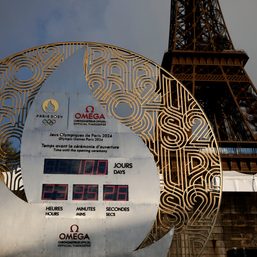SUMMARY
This is AI generated summarization, which may have errors. For context, always refer to the full article.
 A day before the feast of the Black Nazarene, no less than President Benigno Simeon Aquino III publicly announced a bombing plot from local terrorist groups.
A day before the feast of the Black Nazarene, no less than President Benigno Simeon Aquino III publicly announced a bombing plot from local terrorist groups.
The President strongly warned devotees about “the risk in attending the procession” and urged believers “to exercise the maximum vigilance and discipline leading up to, and during, the procession.” The government even declared the whole of Metro Manila under full alert status on January 9 at the height of the Black Nazarene rite, deployed thousands of police with bomb detection squads, and suspended mobile phone services as part of counter-terrorism measures.
After a peaceful 22-hour procession, Malacañang “lifted” the “full alert status” on January 10 as no bombing incident happened.
But police and defense establishments say that Metro Manila is still in “high alert status” because the city is still under terror threats. Six to 9 suspected terrorist bombers are reportedly still at large and law enforcement authorities are currently tracking them down.
Among the suspected terrorists who aimed to disrupt the Black Nazarene procession, the defense department specifically identified the following bombers associated with known dissident terrorist groups in the country: Montasser Esmael Ali (alias Guiday Montassir) from the so-called Special Operations Group (SOG) of the Moro Islamic Liberation Front (MILF), Sheikh Omar Samunsang (alias Omar Abella) from the Rajah Solaiman Islamic Movement (RSIM), and Jamil Sali of the Abu Sayyaf Group (ASG). These groups are suspected to have established links with the Jemaah Islamiyah (JI) and Al-Qaeda.
The Philippines faces a continuing threat of terrorism. The US State Department even laments that the Philippines continues to be one of the world’s safe havens for terrorists, despite the country’s numerous achievements in counter-terrorism a decade after September 11, 2011 (9/11).
There are still active groups with the intent and capabilities to wreak terrorist havoc in the country. A decade after the tragic 9/11 terrorist attacks, these groups have not been totally eliminated. They have, in fact, evolved and have become more resilient, adaptive, innovative and enterprising.
The ASG
The Abu Sayyaf is the main symbol of terrorism in the Philippines. Its ties with Al-Qaeda and JI have been strongly established.
The ASG masterminded several landmark terrorist bombings in the Philippines like the Zamboanga City bombing of 2002, the Davao City Airport bombing of 2003, the Super ferry bombing of February 2004 and the Valentines Day bombing of 2005.
The ASG is also being suspected of having participated in the January 25, 2011 bus bombing in Makati City.
Aside from bombing operations, the ASG is also notorious for numerous kidnap-for-ransom activities such as the Sipadan kidnapping of 2000, the Pearl Farm Beach Resort kidnapping of 2001, the Ces Drillon kidnapping of 2008, the International Committee of the Red Cross (ICRC) kidnapping of 2009, and many others.
The ASG is believed to be currently holding Warren Richard Rodwell, an Australian national kidnapped on December 5, 2011 in Zamboanga Sibugay. Rodwell was transferred to Basilan and is currently in Sulu in the hands of new and young ASG commanders.
There is no doubt that ASG has suffered numerous setbacks from the loss of its senior leaders including Abdurajak Janjalani (the founder), Edwin Angeles (the right-hand man), Khadaffy Janjalani (the successor), Galib Andang (Commander Robot), Aldam Tilao (Abu Sabaya), Alhamser Limbong (Commander Kosovo), and Jainal Antel Sali (Abu Solaiman), among many others.
However, the ASG is a resilient group with the ability to replenish its ranks by luring young, gullible and impoverished individuals to join the “club.” Moreover, the ASG is implementing a combination of benign and coercive recruitment strategies to sustain the life of the organization.
Problems of gangsterism, warlordism, landlordism, clan feuding and violent adventurism also contribute to the staying power of the ASG.
The ASG is believed to be headed now by a veteran ASG commander, Radullan Sahiron. Though Yassir Igasan was initially rumored to have succeeded Khadafy Janjalani, Igasan is the current head of the ASG’s Sharia Court. Both Sahiron and Igasan are based in Sulu along with other commanders like Jumdal Gumbahali (Dr. Abu) and Hajan Sawadjaan.
In Basilan, the known ASG commanders are Khair Mundos, Puruji Indama, and Isnilon Hapilon. However, Hapilon has reportedly died on December 20, 2011 and has been replaced by a young commander named Nadzmir Ali.
Commander Ali is a promising ASG commander with ideological conviction like Igasan. He is believed to be a graduate of the University of the Philippines (UP) like Nur Misuari, the founder of the Moro National Liberation Front (MNLF). Commander Ali operates both in Sulu and Basilan with followers in Zamboanga Sibugay and like-minded friends in Maguindanao. Allegedly, Commander Ali is the one currently holding the Australian kidnap victim.
Because the ASG is now known for its kidnap-for-ransom activities, the group has been described to be a mere bandit group.
Indeed, the ASG is largely composed now of “lawless elements” engaged in banditry and many criminal acts. But there are still a significant few who remain ideological with links with Salafi-Jihadist movements abroad. The US State Department regards the ASG as a foreign terrorist organization.
The ASG frequently operates in Zambasulta area (Zamboanga, Basilan, Sulu and Tawi-Tawi). But the ASG has the fetish to attack Manila. For this purpose, the ASG has a twin-organization in Manila called the Rajah Solaiman Islamic Movement (RSIM).
The RSIM
Founded in 2001 allegedly by Ahmad Santos, the RSIM is a clandestine organization of a radical element of Muslim converts or Balik Islam. Since Santos was arrested in 2005, the RSIM has been declared virtually dead.
The RSIM is believed to be headed now by Khalil Pareja, Santos’ brother-in-law. Pareja was also arrested in 2009 but was eventually released from jail in 2010. Pareja was accused of plotting a terror attack during the 2006 Summit of the Association of Southeast Asian Nations (ASEAN) in Cebu City. Pareja hails from Cebu City. It is now believed that Pareja is reviving the RSIM to mount terror attacks in Manila.
It must be recalled that the RSIM was accused of carrying out the Super ferry bombing in 2004 and participated in the Valentines Day bombing in Makati City in 2005. The RSIM was also identified to be the mastermind of a foiled terror attack on January 9, 2005 during the Black Nazarene procession.
Aside from its link with ASG, the RSIM is also believed to have established links with JI, Al-Qaeda and the so-called MILF-SOG. As such, the RSIM is also regarded as a foreign terrorist organization by the US State Department. The US Treasury Department has listed the RSIM as “Specially Designated Global Terrorist” group.
Other groups
Aside from the ASG and the RSIM, there are other armed groups in Mindanao with the capabilities to make bombs and wreak terrorist havocs.
The so-called MILF-SOG is well known in Central Mindanao for masterminding many bombing activities in the area. Though the MILF vehemently denies the existence of the MILF-SOG, the police and the military establishments believe that the MILF-SOG is being headed by Basit Usman, a bomb-making expert with a price on his head worth US$1 million from the US Rewards for Justice Program.
Aside from its links with the ASG, JI and Al-Qaeda, Usman is also allegedly linked with Al-Khobar Group (AKG) and the Bangsamoro Islamic Freedom Movement (BIFM).
The AKG is notorious in Central Mindanao for its bus extortion activities. Though its key leaders have been arrested and locked in jail, there are followers who continue to use the name to mount extortion operations in Koronadal City, Kidapawan City, Tacurong City and even in General Santos City.
The BIFM, on the other hand, is founded by Ameril Umbra Kato, a former commander of the 105th Base Command of the MILF. The BIFM is presently accused of planting several improvised explosive devices (IEDs) in several towns of Maguindanao, particularly in Cotabato City. Though Kato was reported to have died last December 2011, credible sources say that Kato is alive and kicking.
Because of the ongoing peace talks with the MILF, it is not prudent and proper to describe the MILF as a terrorist group.
But there are personalities associated with the MILF who are accused of terroristic acts.
Even the MNLF is officially not described by the Philippine government as a terrorist group because of the 1996 Peace Agreement. But there are MNLF “rouge personalities” who have also been accused of terrorist acts, particularly those associated with the so-called Nur Misuari Break Away Group (MBG).
The MBG is believed to be supporting the cause of an emerging armed group in Mindanao called the Awliya Group of Freedom Fighters. Operating mainly in Sulu, the Awliya Group was identified to be the principal group behind the suicide attack of a military detachment in Talipao, Sulu on September 25, 2011.
Common grievances
All groups identified above have already developed the superb capability to make bombs. They share not only common grievances and followers, they also share bomb-making skills. These skills are not only being shared among radical Muslim groups. Bomb-making skills have been shared with members of the New People’s Army operating in Mindanao.
All these groups may have differences in strategic intentions. But they share common tactical skills in making bombs made usually of 81 mm mortars and triggered by a mobile phone.
Bomb experts call it a “Bandung device”, which is also being used in Afghanistan, Pakistan, Indonesia, Southern Thailand and elsewhere in the world with groups embracing violent extremism.
Unless we address the underlying conditions that encourage these groups to embrace violent extremism, the Philippines will always face the threat of terrorism.
Unless we convince these groups to embrace peace and leave the use of violence, the Philippines will be, regrettably, in constant fear of terrorist threats. – Rappler.com
Rommel C. Banlaoi is the Executive Director of the Philippine Institute for Peace, Violence and Terrorism Research (PIPVTR) and author of a terrorism research trilogy: Philippine Security in the Age of Terror (2010), Counter-Terrorism Measures in Southeast Asia (2009) and War on Terrorism in Southeast Asia (2004).
Add a comment
How does this make you feel?





There are no comments yet. Add your comment to start the conversation.